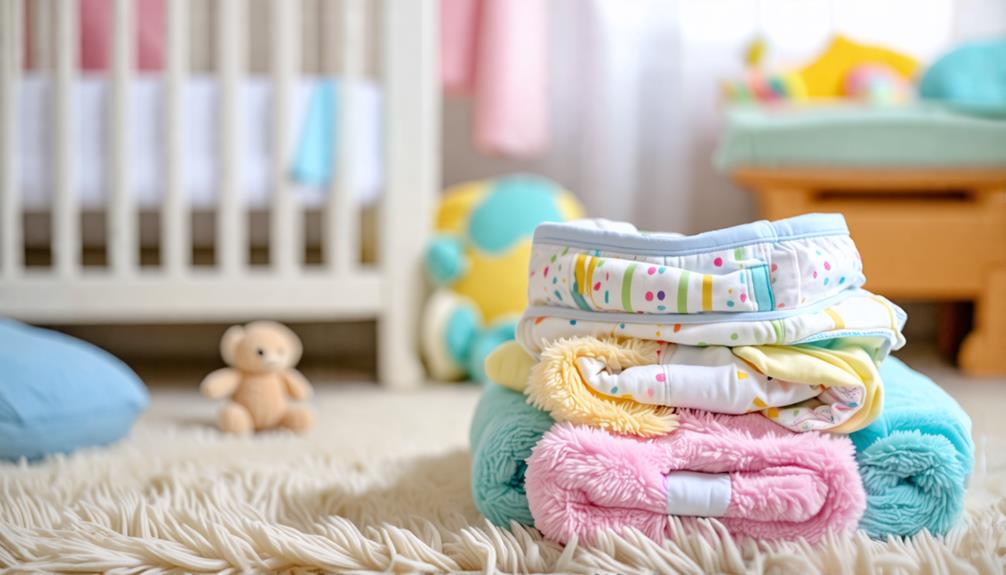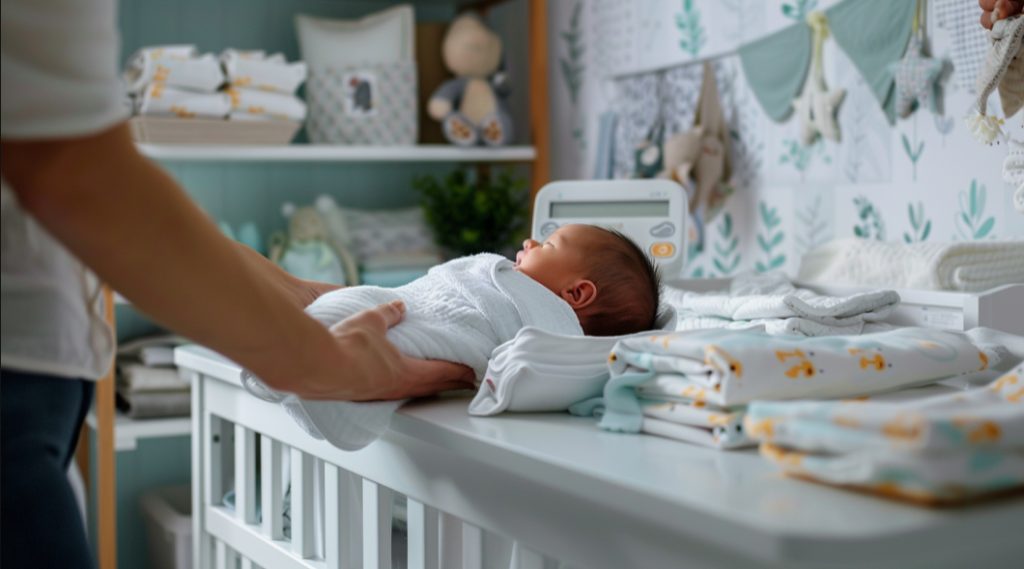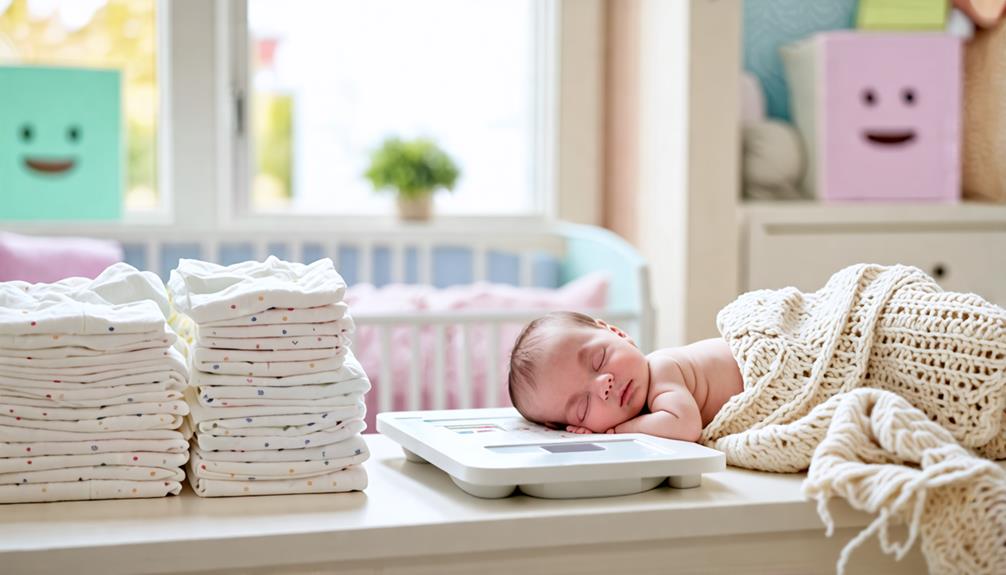Newborn diapers are carefully crafted for infants in their early weeks, supporting weights up to approximately 10 pounds. These diapers offer features like umbilical cord cut-outs and excellent absorbency customized for frequent urination and bowel movements. Proper fit is vital to prevent skin irritation and leakage. Moving from newborn to size 1 diaper typically happens once the infant surpasses 10 pounds, with individual factors such as body shape and skin sensitivity impacting fit effectiveness. Further investigation will offer insights into this critical aspect of newborn care and its impact on overall comfort and health.
Key Takeaways
- Newborn diapers typically fit infants up to around 10 pounds.
- Proper fit is crucial to prevent leakage, skin irritation, and discomfort.
- Weight limits for newborn diapers generally range between 6 to 10 pounds.
- Transitioning to size 1 diapers usually occurs when the baby reaches 10 pounds.
- Newborn diapers feature umbilical cord cut-outs for added comfort and healing.
What Are Newborn Diapers?

Understanding what newborn diapers are is necessary for guaranteeing the comfort and health of a newborn. Newborn diapers are specifically designed to meet the unique needs of infants during their initial weeks of life. These diapers are tailored to accommodate the delicate skin and specific anatomical features of newborns. One key feature is the umbilical cord cut-out, which prevents irritation and promotes healing of the umbilical stump.
Newborn diapers generally provide superior absorbency to manage the frequent urination and bowel movements common in newborns. They employ soft, breathable materials to minimize the risk of diaper rash and other skin irritations. Proper fit is essential; an ill-fitting diaper can lead to various issues such as skin irritation, leakage, and discomfort, potentially impacting the baby’s overall well-being.
Diaper sizes, including newborn diapers, are determined by the baby’s weight rather than age. This approach ensures a snug yet comfortable fit to prevent leaks and maintain skin health. As each brand may differ in sizing guidelines, it is advisable to consult the size chart provided on the diaper packaging for precise fitting. Regular checks and adjustments are necessary to ensure the best comfort and protection as the newborn grows.
Newborn Diapers Go Up to What Weight?
Newborn diapers are usually created to fit babies weighing up to around 10 pounds. This weight limit is set based on typical newborn growth patterns, ensuring a snug yet comfortable fit for most babies in their early days. Caregivers must follow these guidelines to avoid skin irritation and leaks, which can occur due to improper sizing.
Various brands may have slight differences in their size charts, but the general agreement is that newborn diapers will adequately suit babies up to the 10-pound threshold. The design often includes features like an umbilical cord cut-out, offering extra comfort and safety for newborns while they heal.
Healthcare professionals and caregivers should regularly monitor the baby’s weight and growth to decide when to move to the next diaper size. This proactive approach helps uphold ideal hygiene and comfort for the baby.
Why Weight Matters for Diaper Sizing

Weight is a critical factor in diaper selection as it directly correlates with the baby’s size and guarantees a proper fit, which is essential for preventing leaks and skin irritation. However, weight is not the only consideration; the baby’s body shape and mobility also play significant roles in achieving ideal comfort and functionality.
As a result, a thorough approach that includes regular monitoring and adjustments based on growth and developmental changes is recommended for effective diaper sizing.
The Importance of Weight in Diaper Selection
Proper diaper selection is crucial for a newborn’s comfort and health. The weight of the baby is a critical factor in choosing the correct diaper size, as it directly influences the diaper’s fit, absorption capacity, and overall effectiveness. An ill-fitting diaper can lead to skin irritation, urinary tract infections, and discomfort, highlighting the importance of precise weight-based sizing.
To demonstrate the correlation between weight and diaper size, here is a quick reference table:
| Baby Weight (lbs) | Diaper Size | Potential Issues with Incorrect Size |
|---|---|---|
| < 6 | Preemie | Leakage, skin irritation |
| 6-9 | Newborn | Blowouts, umbilical cord irritation |
| 8-14 | Size 1 | Red marks, difficulty in application |
| 12-18 | Size 2 | Excess room, leakage around legs |
| 16-28 | Size 3 | Discomfort, increased risk of diaper rash |
Weight-based diaper selection ensures that the diaper fits snugly yet comfortably, providing optimal absorption and minimizing leakage. Parents and caregivers should regularly monitor the baby’s weight and adjust diaper sizes accordingly, as improper sizing can compromise both hygiene and health. To sum up, closely following weight guidelines is crucial for maintaining the well-being of the newborn.
Weight Isn’t the Only Factor
While a baby’s weight is a primary determinant in diaper selection, other factors also play a significant role in ensuring a proper fit and best comfort. A holistic approach to diaper sizing involves considering the baby’s body shape, skin sensitivity, and mobility. These elements can influence the effectiveness and comfort of the diaper, potentially affecting the baby’s skin health and overall well-being.
Factors affecting diaper fit include:
- Body Shape: Babies vary in body proportions, and some may have chubbier thighs or a rounder belly. Diapers must accommodate these differences to prevent tightness or gaps.
- Skin Sensitivity: Infants with sensitive skin may need a specific diaper material or design to reduce irritation and rashes.
- Mobility: Active babies might require more flexible and secure-fitting diapers to handle increased movement without leaks.
- Frequency of Changes: A higher frequency of diaper changes can affect sizing needs, as a snug fit is essential to avoid leaks during longer wear times.
When Should Babies Switch from Newborn to Size 1 Diapers?
Moving from Newborn to Size 1 diaper typically occurs when the baby reaches approximately 10 pounds, though this can vary based on individual growth patterns. Close monitoring of the infant’s weight and diaper fit is essential for ensuring the best comfort and hygiene. Newborn diapers are generally designed to fit babies up to 10 pounds and often feature an umbilical cord cut-out, which becomes less critical as the baby grows.
A critical indicator for shifting to Size 1 diapers is the presence of frequent leaks or blowouts, suggesting that the diaper can no longer contain the baby’s output effectively. Additionally, if the diaper leaves deep red marks on the skin, it is likely too tight and may require moving to the next size.
Conversely, a diaper that fits too loosely around the legs or waist indicates a need for a larger size.
Healthcare providers and caregivers should regularly assess the baby’s growth and diaper fit. By adhering to evidence-based guidelines and monitoring signs of poorly fitting diapers, caregivers can ensure the baby’s comfort and skin health, thereby promoting overall well-being.
Choosing the Best Newborn Diaper Brand

Selecting the finest newborn diaper brand involves evaluating several key factors to guarantee both comfort and functionality for the infant. Medical professionals emphasize the significance of choosing a diaper that not only fits well but also provides superior absorption and skin protection to prevent common issues such as diaper rash and leaks.
When choosing a newborn diaper brand, consider the following:
- Absorbency: Diapers with high absorption levels keep the baby’s skin dry, reducing the risk of irritation and rashes.
- Fit and Size: Accurate sizing, often determined by the baby’s weight, ensures a snug fit and prevents leaks. Newborn diapers typically feature an umbilical cord cut-out for added comfort.
- Materials: Opt for hypoallergenic and fragrance-free materials to minimize the risk of allergic reactions and skin sensitivities.
- Reputation and Reviews: Brands with positive reviews from healthcare professionals and other parents often indicate reliability and effectiveness.
Evaluating these factors aids in selecting a diaper brand that offers optimal protection and comfort for newborns. Regularly reassessing the fit and size as the infant grows is also essential to maintaining their wellbeing. By choosing the right diaper, caregivers can provide a healthier, more comfortable experience for their newborns.
Looking for a trusted diaper manufacturer? At Winsun, we specialize in producing high-quality, absorbent, and skin-friendly newborn diapers that provide maximum comfort and protection. Whether you’re a retailer or a parent, we’re here to meet your needs.
Contact Winsun today to learn more about our premium range of baby diapers and how we can help you provide the best for your little one.
Frequently Asked Questions
How Often Should I Change a Newborn’s Diaper Daily?
Newborns typically require diaper changes every 2-3 hours or approximately 10-12 times daily to maintain skin health and prevent diaper rash. Frequent changes maintain cleanliness and comfort, reducing the risk of irritation and infections.
What Are the Signs of a Diaper Rash in Newborns?
Like a red flag, diaper rash presents as red, inflamed skin, often accompanied by small bumps or blisters. Symptoms include fussiness during diaper changes, visible irritation, and sensitivity. Prompt treatment helps alleviate discomfort and prevents further complications.
Can Newborn Diapers Be Used for Premature Babies?
Yes, newborn diapers can be used for premature babies if they fit properly. However, preemie-specific diapers are recommended for better fit and comfort, as they are designed to accommodate the smaller size and delicate skin of preterm infants.
Are There Eco-Friendly Options for Newborn Diapers?
In the journey to a greener planet, eco-friendly newborn diaper options include biodegradable disposable diapers and organic cloth diapers. These alternatives reduce environmental impact and are often crafted from sustainable materials, ensuring both baby comfort and ecological responsibility.
Read More: Disposable Diapers Vs Cloth Diapers
How Do I Dispose of Newborn Diapers Properly?
Proper disposal of newborn diapers involves sealing them in a plastic bag to contain odors and bacteria, then placing them in a designated diaper pail or trash bin. Follow local waste management guidelines for specific disposal instructions.
See Also – Disposable Nappies Facts
Conclusion
Securing correct diaper sizing is essential in preventing leaks and skin irritation in newborns. Newborn diapers usually fit babies up to 10 pounds, although there are brand differences. Timely progression to the next size is vital as babies develop. As the saying goes, “A stitch in time saves nine.” Following weight recommendations and identifying signs of incorrect sizing guarantees peak comfort and hygiene, which are fundamental aspects of neonatal care.


